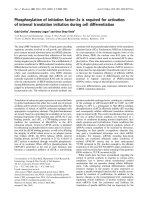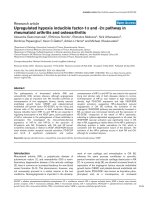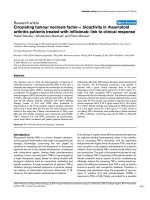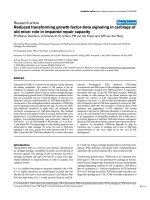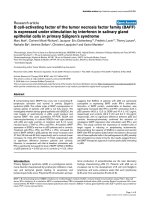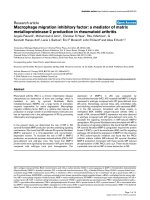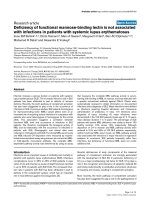Báo cáo y học: "Wildtype epidermal growth factor receptor (Egfr) is not required for daily locomotor or masking behavior in mice" pps
Bạn đang xem bản rút gọn của tài liệu. Xem và tải ngay bản đầy đủ của tài liệu tại đây (643.39 KB, 5 trang )
BioMed Central
Page 1 of 5
(page number not for citation purposes)
Journal of Circadian Rhythms
Open Access
Short paper
Wildtype epidermal growth factor receptor (Egfr) is not required
for daily locomotor or masking behavior in mice
Reade B Roberts
1
, Carol L Thompson
2
, Daekee Lee
1
, Richard W Mankinen
1
,
Aziz Sancar
2
and David W Threadgill*
1
Address:
1
Department of Genetics, CB 7264, University of North Carolina at Chapel Hill, Chapel Hill, NC 27599, USA and
2
Department of
Biochemistry, CB 7260, University of North Carolina at Chapel Hill, Chapel Hill, NC 27599, USA
Email: Reade B Roberts - ; Carol L Thompson - ; Daekee Lee - ;
Richard W Mankinen - ; Aziz Sancar - ; David W Threadgill* -
* Corresponding author
Abstract
Background: Recent studies have implicated the epidermal growth factor receptor (EGFR) within
the subparaventricular zone as being a major mediator of locomotor and masking behaviors in
mice. The results were based on small cohorts of mice homozygous for the hypomorphic Egfr
wa2
allele on a mixed, genetically uncontrolled background, and on intraventricular infusion of
exogenous EGFR ligands. Subsequenlty, a larger study using the same genetically mixed background
failed to replicate the original findings. Since both previous approaches were susceptible to
experimental artifacts related to an uncontrolled genetic background, we analyzed the locomotor
behaviors in Egfr
wa2
mutant mice on genetically defined, congenic backgrounds.
Methods: Mice carrying the Egfr
wa2
hypomorphic allele were bred to congenicity by backcrossing
greater than ten generations onto C57BL/6J and 129S1/SvImJ genetic backgrounds. Homozygous
Egfr
wa2
mutant and wildtype littermates were evaluated for defects in locomotor and masking
behaviors.
Results: Mice homozygous for Egfr
wa2
showed normal daily locomotor activity and masking
indistinguishable from wildtype littermates at two light intensities (200–300 lux and 400–500 lux).
Conclusion: Our results demonstrate that reduced EGFR activity alone is insufficient to perturb
locomotor and masking behaviors in mice. Our results also suggest that other uncontrolled genetic
or environmental parameters confounded previous experiments linking EGFR activity to daily
locomotor activity and provide a cautionary tale for genetically uncontrolled studies.
Background
The epidermal growth factor receptor (EGFR) pathway
plays key roles in the development and maintenance of
many tissue and organ systems [1]. Recent reports have
suggested that the EGFR pathway mediates two aspects of
behavior, diurnal locomotor activity and suppression of
locomotion in response to light (masking). Levels of the
EGFR ligand transforming growth factor alpha (TGFA)
fluctuate with a circadian rhythm within the suprachias-
matic nucleus (SCN) [2,3], which is located within the
hypothalamus and is considered the primary anatomical
circadian clock, and are associated with circadian time-
Published: 16 November 2006
Journal of Circadian Rhythms 2006, 4:15 doi:10.1186/1740-3391-4-15
Received: 20 October 2006
Accepted: 16 November 2006
This article is available from: />© 2006 Roberts et al; licensee BioMed Central Ltd.
This is an Open Access article distributed under the terms of the Creative Commons Attribution License ( />),
which permits unrestricted use, distribution, and reproduction in any medium, provided the original work is properly cited.
Journal of Circadian Rhythms 2006, 4:15 />Page 2 of 5
(page number not for citation purposes)
dependent changes in gene expression [4]; similarly,
EGFR ligands are expressed within cells of the retina,
which modulates masking behavior [3]. Both of these
structures appear to input into the subparaventricular
zone (SPZ), a hypothalamic region that is required for cir-
cadian rhythms [5] and that expresses high levels of EGFR
[3]. This anatomical network has been experimentally
manipulated, with infusion of TGFA into the hamster
hypothalamus reversibly suppressing locomotor activity
[3,6]. However, exogenous administration of receptor lig-
ands can lead to non-physiological responses, indicating
what a protein can do, not necessarily its normal biologi-
cal function [7].
Perhaps the most compelling evidence implicating the
EGFR pathway in locomotor activity and masking was
found in the behavior of mice homozygous for the Egfr
wa2
allele, which produces a hypomorphic receptor with
reduced kinase activity [8,9]. The Egfr
wa2
allele is a valua-
ble genetic reagent for dissecting biological functions of
EGFR since homozygosity for Egfr null alleles results in
lethality [1,10], while Egfr
wa2
homozygous animals can
survive to adulthood. Both abnormally high diurnal activ-
ity and strong masking defects were reported in four of
five B6EiC3H-a/A-Egfr
wa2/wa2
Wnt3a
vt/vt
mice tested [3].
Conflicting with these observations, a larger study using a
greater number of mice from the same source (The Jack-
son Laboratory) and a range of illumination intensities
did not detect any masking defects [11].
Previous analyses investigating alterations in locomotor
and masking behaviors used mice carrying the Egfr
wa2
allele on a mixed genetic background. In order to resolve
the discrepancies implicating a critical role for EGFR in
locomotor and masking behaviors, as well as to examine
potential genetic background effects on these defects, we
tested Egfr
wa2
homozygotes on uniform congenic or
hybrid backgrounds for locomotor activity and masking
ability. The current results conclusively demonstrate that
EGFR is not an essential mediator of locomotor or mask-
ing behaviors and suggests that other uncontrolled genetic
or environmental parameters confounded previous exper-
iments.
Methods
B6EiC3H-a/A-Egfr
wa2/wa2
Wnt3a
vt/vt
mice were obtained
from The Jackson Laboratory (Bar Harbor, ME). The deri-
vation of the Egfr
wa2
congenic lines involved backcrossing
the Egfr
wa2
allele for greater than ten generations to
C57BL/6J and 129S1/SvImJ genetic backgrounds. The
removal of the linked Wnt3a
vt
hypomorphic allele, main-
tained in cis with Egfr
wa2
in the initial starting population,
was verified by PCR-based genotyping. Mice were given at
least one week to acclimate to their new environment
prior to testing. Mice were provided PicoLab Mouse Diet
20 (LabDiet) ad libitum and autoclaved water.
Mice were housed singly and habituated several days in
cages equipped with running wheels for activity measure-
ments, within a light-tight box containing a cool-white
fluorescent tube providing 200 to 300 lux or 400 to 500
lux light at cage level on a 12 h:12 h light-dark cycle. Diur-
nal activity was calculated as the percentage of total activ-
ity occurring in the light phase of the cycle. For the
masking response analysis, either one or three hour light
pulses were delivered on the third day starting at Zeitgeber
Time (ZT) 14 (ZT0 = light on; ZT12 = lights off). Each ani-
mal was tested for masking to two or three light pulses
with at least two days between pulses. Activity during the
pulse was calculated as a percentage of the activity at the
same time on the previous day. Locomotor activity was
recorded and analyzed with ClockLab software (Actimet-
rics, Evanston, IL).
Results and discussion
Mice with normal light-mediated locomotor activity gen-
erally have one to two percent daytime activity, and mask-
ing of greater than 95%. An initial round of testing
utilized commonly administered conditions, one-hour
light pulses at 400–500 lux, to determine masking
response. Of the six animals tested, none showed a mask-
ing defect, and only a single animal, an Egfr
wa2/wa2
Wnt3a
vt/
vt
mouse on a mixed genetic background similar to those
previously used [3], demonstrated higher than normal
diurnal activity (data not shown).
A larger panel of mice was then tested using three-hour
light pulses at 200–300 lux, conditions identical to those
of the previous study reporting Egfr
wa2
-associated abnor-
malities [3]. Surprisingly, the vast majority of Egfr
wa2
homozygous mice exhibited both normal daytime activity
and negative masking, as did all wild-type littermates and
a C57BL/6J-Wnt3a
vt/vt
mouse (Table 1). Indeed, no statis-
tically significant differences were found when the data
were grouped by Egfr status (one-way ANOVA: % daytime
activity, p = 0.32; % masking, p = 0.27; total activity (rev),
p = 0.49). Two Egfr
wa2/wa2
mice, one male C57BL/6J-
Egfr
wa2/wa2
and one female B6.129 F1-Egfr
wa2/wa2
, exhibited
both abnormal daytime activity and negative masking
defects similar, but not as extreme, as those previously
described [3]. Unlike what happened in the previous
study, the majority of the abnormally high daytime activ-
ity seen in the two affected mice was not sporadic, but
rather occurred in a discrete time period anticipating the
dark cycle and thus resulting in a consistent phase shift
(Fig. 1A). Similar to the previous study, the negative mask-
ing in mice was delayed, with normal suppression of
activity in the first hour of the three-hour light pulse (Fig.
1B). Thus, the current results on controlled genetic back-
Journal of Circadian Rhythms 2006, 4:15 />Page 3 of 5
(page number not for citation purposes)
grounds show substantially less penetrance and expressiv-
ity than originally reported (18% versus 80% penetrance)
[3].
The discrepancy between previous results using the
B6EiC3H mixed genetic background and our current
results with congenic mice is particularly surprising since
most abnormal phenotypes increase in severity with
inbreeding, this being particularly striking for phenotypes
associated with Egfr [1,12]. However, use of the B6EiC3H-
a/A-Egfr
wa2
Wnt3a
vt
stock to study effects of the Egfr
wa2
allele is immediately problematic since Egfr
wa2
homozy-
gotes are also homozygous for the linked Wnt3a
vt
muta-
tion, a hypomorphic allele of Wnt3a known for producing
the vestigial tail phenotype [13]. Since Wnt3a-deficient
mice exhibit defects in the hippocampus and central nerv-
ous system [14], the Wnt3a
vt
allele is possibly responsible
for the activity defects. Additionally, the non-inbred
B6EiC3H background, maintained through a cross-out-
cross mating scheme, harboring the Egfr
wa2
and Wnt3a
vt
alleles in cis segregates known and unknown mutations
from the C57BL/6JEi and C3H/HeSnJ strains [15]. Conse-
quently, defects like those previously reported for loco-
motor activity cannot be attributed to Egfr because an
appropriate control does not exist for the mixed B6EiC3H
background.
Wildtype inbred mice from the C57BL/6JEi and C3H/
HeSnJ strains have different masking thresholds and vary
in diurnal locomotor activity in a manner that is likely
multigenic [16,17]. One strong candidate for such a mod-
ifier mutation is retinal degeneration (Pdeb
rd1
), which is car-
ried by the C3H/HeSnJ strain but not C57BL/6EiJ, and
causes progressive and selective degeneration of photore-
ceptor cells [18,19]; the Pdeb
rd1
mutation alone has a
highly significant effect on masking behavior [16]. Mela-
tonin production is also vastly different between the two
strains contributing to the B6EiC3H mixed background,
with C3H mice exhibiting high, rhythmic melatonin lev-
els, and C57BL/6 mice exhibiting low to undetectable
melatonin levels caused by mutation of at least one gene
(N-acetyltransferase 2) related to melatonin production
[20,21]. The previous Egfr
wa2
homozygous cohort that had
a high penetrance of activity defects may have fortuitously
contained a high frequency of these or other genetic mod-
ifiers given the small number of individuals tested.
Previous studies utilizing direct infusion of ligand to
hyperactivate EGFR in the brain have shown that abnor-
mally high EGFR signaling is capable of perturbing light-
associated locomotor activity control [3,6]. However,
such an approach can produce non-physiological
responses that are artifactual or neomorphic in nature
rather than being representative of normal biology [7].
Thus, the suggestion that locomotor activity is strongly
dependent on normal levels of EGFR signaling is not sup-
ported, especially since extensive testing of B6EiC3H-a/A
Egfr
wa2/wa2
Wnt3a
vt/vt
mice across a wide range of lighting
conditions failed to detect any differences in masking
response [11]. Using appropriately controlled genetic
conditions, our results conclusively demonstrate that
EGFR activity is not required to produce and is not a major
mediator of abnormal activity phenotypes, and that other
environmental, genetic, or stochastic effects are required
Table 1: Activity measurements at 200–300 lux
Mouse number Strain Genotype Total activity
a
Daytime activity
b
Masking
c
1 C57BL/6J + 30154 1.82 99.33
2 C57BL/6J + 37951 0.28 99.45
3 C57BL/6J + 44485 0.86 97.35
4 C57BL/6J Wnt3a
vt/vt
23509 1.43 99.72
5 B6.129 F1 + 51014 1.44 95.82
6 B6.129 F1 + 39133 0.74 96.10
7 C57BL/6J Egfr
wa2/wa2
27630 30.22 66.25
8 C57BL/6J Egfr
wa2/wa2
21821 1.30 95.82
9 C57BL/6J Egfr
wa2/wa2
40884 0.08 99.97
10 C57BL/6J Egfr
wa2/wa2
33975 1.16 97.80
11 C57BL/6J Egfr
wa2/wa2
31997 0.55 97.97
12 C57BL/6J Egfr
wa2/wa2
38165 1.95 80.49
13 C57BL/6J Egfr
wa2/wa2
35818 0.98 99.37
14 C57BL/6J Egfr
wa2/wa2
37774 0.39 99.27
15 C57BL/6J Egfr
wa2/wa2
21888 1.92 97.39
16 B6.129 F1 Egfr
wa2/wa2
43930 17.55 26.63
17 B6.129 F1 Egfr
wa2/wa2
46505 1.41 97.50
a
Average number of wheel revolutions per twenty-four hour period.
b
Percentage of total wheel revolutions during light cycle.
c
Percent suppression of activity during three-hour light pulse given during the dark cycle, relative to activity in the same dark cycle time period on
the previous day.
Journal of Circadian Rhythms 2006, 4:15 />Page 4 of 5
(page number not for citation purposes)
Locomotor activity in Egfr
wa2/wa2
mice during 12 h:12 h light:dark cycles and three-hour light pulses given during the dark cycleFigure 1
Locomotor activity in Egfr
wa2/wa2
mice during 12 h:12 h light:dark cycles and three-hour light pulses given dur-
ing the dark cycle. Horizontal white and black bars represent light and dark exposure, respectively. Vertical axis indicates
wheel-running activity. (A) The majority of Egfr
wa2/wa2
mice tested were indistinguishable from wildtype controls in behavior,
though two Egfr
wa2/wa2
mice did exhibit a phase shift resulting in abnormally high daytime activity, as well as abnormally high
activity during a three hour light pulse. (B) Abnormal wheel running activity during three-hour light pulses followed a character-
istic one-hour of activity suppression in three Egfr
wa2/wa2
mice (red), while wildtype (dark blue) and the majority of Egfr
wa2/wa2
mice (light blue) demonstrated suppression of activity throughout the pulse. Grey areas, lights off; white area, light pulse.
Journal of Circadian Rhythms 2006, 4:15 />Page 5 of 5
(page number not for citation purposes)
to reveal abnormal phenotypes. A recent report revealed
significant intrastrain and intraindividual fluctuations of
EGFR ligand levels in the SCN of inbred mice [2]. Thus we
cannot eliminate the possibility that homozygosity for
Egfr
wa2
may cause individuals to be sensitized to pheno-
typically express abnormal locomotor activities. For
example, Egfr
wa2
homozygotes have variable eye defects
[8] that could combine with other factors to contribute to
light-associated activity abnormalities. In fact one of the
Egfr
wa2/wa2
individuals in our study supports the presence
of intraindividual variability, exhibiting an abnormal
masking response in one trial followed by a near-normal
response in a subsequent trial (data not shown).
Conclusion
The mice used to originally implicate EGFR as a major
mediator of locomotor activity carried numerous other
mutations and allelic variants that could contribute to the
observed results. Since the animals were not properly con-
trolled for genetic background, numerous other interpre-
tations (such as unequal genetic background distribution
in control and test mice) most likely contributed to the
erroneous results. Our data using genetically uniform con-
genic lines indicate that EGFR is not a required mediator
of the locomotor or masking behaviors, though it may
modulate the activity of other pathways involved in con-
trol of locomotor activity. Further investigation is
required to properly elucidate the molecular pathways
and factors mediating locomotor activity.
Competing interests
The author(s) declare that they have no competing inter-
ests.
Authors' contributions
RBW participated in all experiments, in the analysis and
discussion of the results, and in the writing of the manu-
script. CLT participated in all experiments, in the analysis
and discussion of the results, and in the writing of the
manuscript. DL participated in all experiments and in the
analysis and discussion of the results. RWM participated
in all experiments and in the analysis and discussion of
the results. AS participated in the conceptualization of the
experiments and in the analysis and discussion of the
results. DWT participated in the conceptualization of the
experiments, in the analysis and discussion of the results,
and in the writing of the manuscript. All authors read and
approved the final manuscript.
Acknowledgements
This work was supported by grants from the National Institutes of Health
(CA092479 and HD039896) to DWT and (GM031082) to AS.
References
1. Threadgill DW, Dlugosz AA, Hansen LA, Tennenbaum T, Lichti U,
Yee D, LaMantia C, Mourton T, Herrup K, Harris RC, Barnard JA,
Yuspa SH, Coffey RJ, Magnuson T: Targeted disruption of mouse
EGF receptor: effect of genetic background on mutant phe-
notype. Science 1995, 269:230-234.
2. Van der Zee EA, Roman V, Ten Brinke O, Meerlo P: TGFalpha and
AVP in the mouse suprachiasmatic nucleus: anatomical rela-
tionship and daily profiles. Brain Res 2005, 1054(2):159-166.
3. Kramer A, Yang FC, Snodgrass P, Li X, Scammell TE, Davis FC, Weitz
CJ: Regulation of daily locomotor activity and sleep by
hypothalamic EGF receptor signaling. Science 2001,
294(5551):2511-2515.
4. Zak DE, Hao H, Vadigepalli R, Miller GM, Ogunnaike BA, Schwaber J:
Systems analysis of circadian time-dependent neuronal epi-
dermal growth factor receptor signaling. Genome Biol 2006,
7:R48.1-15.
5. Saper CB, Scammell TE, Lu J: Hypothalamic regulation of sleep
and circadian rhythms. Nature 2005, 437:1257-1263.
6. Snodgrass-Belt P, Gilbert JL, Davis FC: Central administration of
transforming growth factor-alpha and neuregulin-1 suppress
active behaviors and cause weight loss in hamsters. Brain
Research 2005, 1038:171-182.
7. Wakefield LM, Yang Y, Dukhanina O: Transforming growth fac-
tor-beta and breast cancer: essons learned from genetically
altered mouse models. Breast Cancer Research 2000, 2:100-106.
8. Luetteke NC, Phillips HK, Qiu T, Copeland NG, Earp HS, Jenkins NA,
Lee DC: The mouse waved-2 phenotype results from a point
mutation in the EGF receptor tyrosine kinase. Genes and
Development 1994, 8:399-413.
9. Fowler KJ, Walker F, Alexander W, Hibbs ML, Nice EC, Bohmer RM,
Mann GB, Thumbwood C, Maglitto R, Danks JA, Chetty R, Burgess
AW, Dunn AR: A mutation in the epidermal growth factor
receptor in waved-2 mice has a profound effect on the recep-
tor biochemistry that results in impaired lactation. Proceed-
ings of the National Academy of Sciences USA 1995, 92:1465-1469.
10. Sibilia M, Wagner EF: Strain-dependent epithelial defects in
mice lacking the EGF receptor.
Science 1995, 269:234-238.
11. Mrosovsky N, Redlin U, Roberts RB, Threadgill DW: Masking in
waved-2 mice: Egf receptor control of locomotion quesi-
toned. Chronobiol Int 2005, 22:963-974.
12. Strunk KE, Amann V, Threadgill DW: Phenotypic variation result-
ing from a deficiency of epidermal growth factor receptor in
mice is caused by extensive genetic heterogeneity that can
be genetically and molecularly partitioned. Genetics 2004,
167:1821-1832.
13. Greco TL, Takada S, Newhouse MM, McMahon JA, McMahon AP,
Camper SA: Analysis of the vestigial tail mutation demon-
strates that Wnt-3a gene dosage regulates mouse axial dev-
leopment. Genes and Development 1996, 10:313-324.
14. Lee SM, Tole S, Grove E, McMahon AP: A local Wnt-3a signal is
required for development of the mammalian hippocampus.
Development 2000, 127:457-467.
15. Staff: Genetic background effects: can your mice see? In JAX
Notes Bar Harbor , Jackson Laboratory; 2002.
16. Mrosovsky N, Foster RG, Salmon PA: Thresholds for masking
responses to light in three strains of retinally degenerate
mice. J Comp Physiol [A] 1999, 184(4):423-428.
17. Tankersley CG, Irizarry R, Flanders S, Rabold R: Circadian rhythm
variation in activity, body temperature, and heart rate
between C3H/HeJ and C57BL/6J inbred strains. J Appl Physiol
2002, 92(2):870-877.
18. White JA, Burgess BJ, Hall RD, Nadol JB: Pattern of degeneration
of the spiral ganglion cell and its processes in the C57BL/6J
mouse. Hear Res 2000, 141(1-2):12-18.
19. Wang S, Villegas-Perez MP, Vidal-Sanz M, Lund RD: Progressive
optic axon dystrophy and vacuslar changes in rd mice. Invest
Ophthalmol Vis Sci 2000, 41(2):537-545.
20. Ebihara S, Marks T, Hudson DJ, Menaker M: Genetic control of
melatonin synthesis in the pineal gland of the mouse. Science
1986, 231(4737):491-493.
21. Vivien-Roels B, Malan A, Rettori MC, Delagrange P, Jeanniot JP, Pevet
P: Daily variations in pineal melatonin concentrations in
inbred and outbred mice. J Biol Rhythms 1998, 13(5):403-409.

